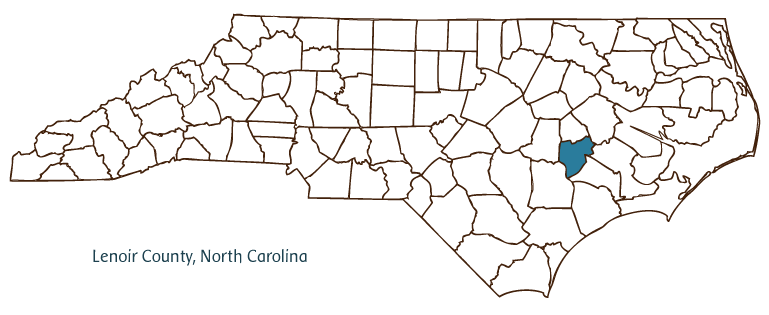Lenoir County Resources
- View All:
- Biographies
- Monuments
- locations
Copyright Notice: This article is from the Encyclopedia of North Carolina edited by William S. Powell. Copyright © 2006 by the University of North Carolina Press. Used by permission of the publisher. For personal use and not for further distribution. Please submit permission requests for other use directly to the publisher.

See also: Kinston, Battle of; Neuse, CSS, State Historic Site and Governor Richard Caswell Memorial; Wyse Fork, Battle of.
Lenoir County, located in North Carolina's Coastal Plain region, was formed from no-longer-extant Dobbs County in 1791. It was named for General William Lenoir, a prominent Revolutionary War hero, Speaker of the State Senate, and trustee of the University of North Carolina. The new county retained Dobbs County's seat, Kinston, which was incorporated in 1762 as Kingston (in honor of King George III). Other communities in Lenoir County include La Grange, Pink Hill, Graingers, Deep Run, Institute, Dawson, and part of Grifton. The county's estimated population was 58,500 in 2004.
Although it continues to produce traditional agricultural commodities such as tobacco, Lenoir County has also been on the cutting edge of new business ventures. In 1954 the DuPont Company established its first polyester manufacturing plant in the county. During the 1990s, the county again made history with the construction of the Global TransPark, an innovative, fully integrated business and transportation complex (although it has been plagued by tenancy and financing problems).
Among Lenoir County's many attractions are the Kinston Indians Class-A baseball team-Kinston is the smallest city in the nation with a professional team-and the CSS Neuse State Historic Site and Governor Richard Caswell Memorial, where visitors can view a Confederate ironclad gunboat, the CSS Neuse. The ship, which was deliberately sunk by its captain in 1865 to prevent it from falling into Union hands, was found to be in remarkably good condition when it was recovered nearly a century later. Nearly 15,000 associated artifacts were recovered along with the ship. Lenoir County was also the scene of two major Civil War engagements, the 1862 Battle of Kinston and the 1865 Battle of Wyse Fork, second only (among actions fought in North Carolina) to the Battle of Bentonville in the number of troops engaged.
For an annotated history of the county's formation, with the laws affecting the county, boundary lines and changes, and other origin information, visit these references in The Formation of the North Carolina Counties (Corbitt, 2000), available online at North Carolina Digital Collections (note, there may be additional items of interest for the county not listed here):
County formation history: https://digital.ncdcr.gov/Documents/Detail/the-formation-of-the-north-ca...
Index entry for the county: https://digital.ncdcr.gov/Documents/Detail/the-formation-of-the-north-ca...
References:
Heritage of Lenoir County, 1981 (1981).
Additional resources:
Corbitt, David Leroy. 2000. The formation of the North Carolina counties, 1663-1943. https://digital.ncdcr.gov/Documents/Detail/the-formation-of-the-north-carolina-counties-1663-1943/3692099?item=4553233 (accessed June 20, 2017).
Lenoir County Government: https://lenoircountync.gov/
Kinston-Lenoir County Chamber of Commerce: https://www.kinstonchamber.com/
DigitalNC, Lenoir County: https://www.digitalnc.org/counties/lenoir-county/
North Carolina Digital Collections (explore by place, time period, format): https://digital.ncdcr.gov
Image credits:
Rudersdorf, Amy. 2010. "NC County Maps." Government & Heritage Library, State Library of North Carolina.
Vocci, Robert Blair. "Lenoir County." NCpedia. State Library of NC. 2006. https://www.ncpedia.org/geography/lenoir.